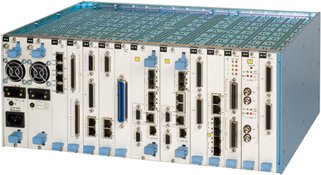Wired Transport
Multiplexers
A multiplexer, often abbreviated as “MUX,” is a digital electronic device or circuit that allows multiple input signals to be combined and transmitted through a single output. It selects and routes the input signals based on control inputs, enabling the sharing of a single communication channel or transmission line among multiple sources. In essence, a multiplexer is like a data switch that selects one of several inputs and forwards it to the output

Demarcation Devices
Demarcation devices refer to equipment or devices that are used to establish a clear boundary or separation between different networks or service areas. They are typically employed in telecommunications and networking to demarcate the point where a service provider’s responsibility ends and the customer’s responsibility begins. Demarcation devices help define and protect the network interface, ensuring that each party is accountable for their respective network operations and maintenance.

DWDM/WDM
DWDM stands for Dense Wavelength Division Multiplexing, while WDM stands for Wavelength Division Multiplexing. Both are technologies used in optical fiber communication to increase the capacity and efficiency of transmitting multiple signals over a single fiber optic cable. WDM allows multiple optical signals, each with a different wavelength (or color), to be transmitted simultaneously through the same fiber. This is achieved by combining the signals at the transmitting end using different wavelengths and then separating them at the receiving end based on their wavelengths.

Optical Line Terminal
Optical Line Terminal (OLT) is a networking device used in fiber optic communication systems. It serves as the endpoint of a passive optical network (PON) and facilitates the transmission of data between a service provider’s central office and the subscriber’s premises. The OLT functions as a central hub, managing and controlling the flow of information to and from multiple Optical Network Units (ONUs) or Optical Network Terminals (ONTs) connected to it. In essence, the OLT acts as the gateway for data traffic in a fiber optic network, enabling high-speed and efficient communication.

Optical Network Unit
The Optical Network Unit (ONU) is a device used in fiber-optic communication networks. It is typically located at the customer’s premises and serves as the interface between the customer’s equipment and the service provider’s optical network. The ONU receives optical signals from the provider’s network and converts them into electrical signals that can be used by devices such as computers, telephones, or other network equipment. It also performs functions such as signal amplification, protocol conversion, and data routing. In summary, the ONU enables high-speed data transmission over fiber-optic networks to connect customers to the internet or other communication services.

Optical Transport Network
Optical Transport Network (OTN) refers to a high-speed, high-capacity telecommunications network that utilizes optical fiber technology to transport large volumes of data over long distances. It provides a standardized framework for multiplexing and transmitting different types of traffic, such as voice, video, and data, in a reliable and efficient manner. OTN offers advanced features like error correction, fault management, and scalability, making it a critical infrastructure for modern telecommunications systems.

Media Converter
A media converter is a device or software that converts media files from one format to another. It enables the conversion of various types of media such as audio, video, and images, allowing them to be compatible with different devices or platforms. Media converters are commonly used to convert file formats for playback on different devices, sharing files online, or editing purposes.

